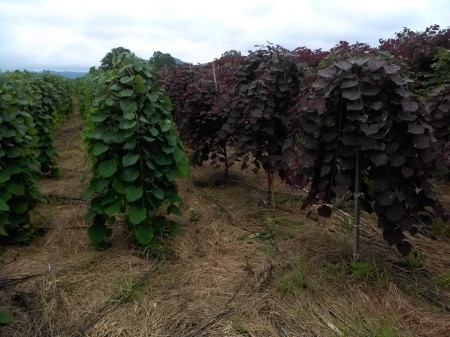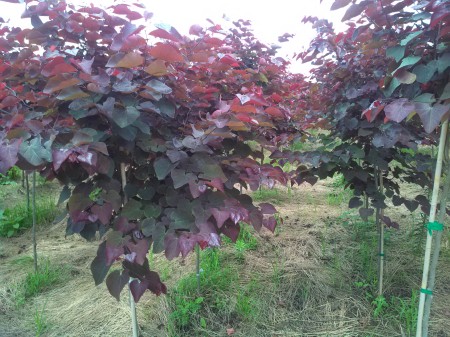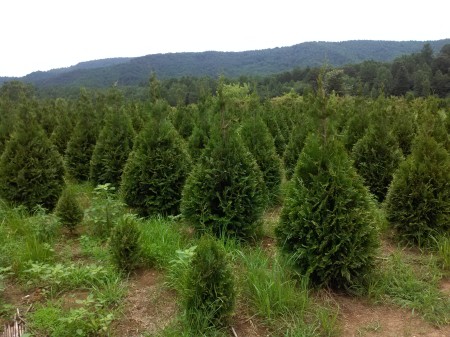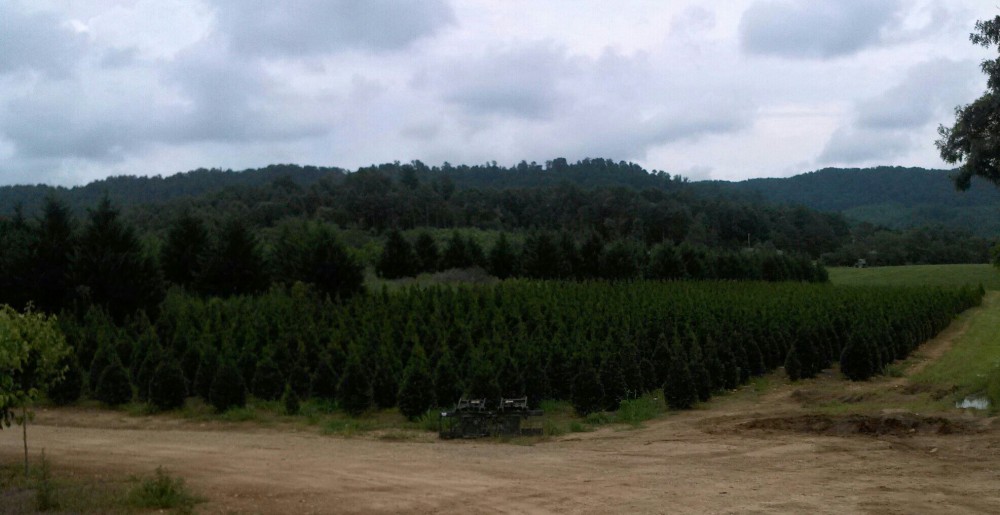 Humidity settles into the bottom lands of the North Carolina mountains early in the day. Even on this cooler than average July morning a considerable sweat is worked up on a short walk through a field of ‘Stellar Pink’ dogwoods (Cornus x ‘Rutgan’, below). Today, more walking than usual is required because recent heavy rains have turned much of the grass covered field to marshland.
Humidity settles into the bottom lands of the North Carolina mountains early in the day. Even on this cooler than average July morning a considerable sweat is worked up on a short walk through a field of ‘Stellar Pink’ dogwoods (Cornus x ‘Rutgan’, below). Today, more walking than usual is required because recent heavy rains have turned much of the grass covered field to marshland.
A typical tour of a tree growing nursery is jarring experience, with the pickup truck bouncing through every hole and tractor rut, but the bumpy ride is mandatory to see many acres of trees in fields that are scattered over too many miles. In other parts of the country nurseries are consolidated into larger fields, but these bottom lands are bordered by steep mountains, so spaces with workable grades are limited.
Slow growing hemlocks and spruce are grown on steep, but well drained slopes, where digging and balling trees is particularly laborious. But, steep grade or only gently sloping, raising and harvesting trees is hard work, made more difficult by the mud and thick air. By comparison, touring nurseries to select trees for the following spring is only a minor annoyance to a garden center and landscape buyer more accustomed to an air conditioned office than slogging through mud and tall grasses.
The benefits of growing trees in the bottom land are obvious. Well drained, rich, and mostly rock free soils promote fast growth, and nearly every field of trees is bordered by a large creek for irrigation. But, no supplemental watering has been needed this summer. Rather, flash floods are a greater concern, with rainwater gushing down the mountainsides to swell the creeks far beyond their banks. Small, homemade bridges are routinely washed downstream, but as quickly as the flood waters rise, they subside, and few trees are damaged.
Weeds and tall grasses border neat rows of trees, and in a season of daily storms weeds are barely controlled by mowing and spraying herbicides. Walking through knee high (and sometimes waist high) grasses to see rows of redbuds (Cercis canadensis) and Black gums (Nyssa sylvatica) is an adventure in avoiding deep holes from trees dug in the spring, while being aware that this is a haven for snakes (which, fortunately are rarely encountered).
With abundant moisture and rich soil, foliage of dogwoods and redbuds grows large and thick, but in this rainy season powdery mildew is a concern that growers must continually address or growth will be stunted. The lush growth can disguise a sparsely branched tree, so foliage of many trees is pushed aside to examine the branching structure. When the tree is dug and balled in burlap roots will be cut and leaves will be smaller than usual until the tree rebounds from the transplant, so the form and density of branching is critical to avoid spindly and poorly shaped trees.
An average shade or flowering tree takes three to five years to grow to the size suitable for landscaping, so tree growers must assess the market to figure the quantities and varieties of trees to grow. Every year there are new varieties of trees, and others that lose their popularity, so the grower must understand these factors or suffer from trees that don’t sell, become overgrown, and must eventually be grubbed out by large equipment.
On today’s nursery tour the grower has begun growing handfuls of recently introduced redbuds. The yellow leafed ‘Rising Sun’ is a bit too small for digging until the following year, but weeping redbuds ‘Pink Heartbreaker’ and the the red leafed ‘Ruby Falls’ are substantial enough to dig in the spring. Their long branches nearly reach the ground, but these will be cut back and more growth will give the trees the necessary fullness.
I’ve been visiting this grower for thirty years, and there have been considerable changes through the years. Once, these fields were filled with Leyland cypresses and green leafed maples, dogwoods, and redbuds, but instead now there are acres of Green Giant arborvitae and red, yellow, and variegated leaf flowering trees.
The Green Giants in this field are a bit over six feet tall, but they will end the summer over eight feet. Green Giant arborvitae (Thuja standishii x plicata ‘Green Giant’) is a sturdy and fast growing evergreen that transplants readily and resists browsing by deer and damage from snow and wind that too often plagues Leyland cypress, and many acres are devoted to growing ones up to sixteen feet tall. While deciduous maples, dogwoods, and redbuds are usually dug only when dormant, the arborvitae can be dug through the summer, as long as there is adequate moisture in the ground, And, today there’s plenty of that.
Thank you for a very educational post!
dogwoods and redbuds are always popular around here I see them all the time being planted in newly built homes and relandscaped yards, people like the heart shaped leaves and pretty flowers in spring, dogwoods is a given everyone likes those, I know I do. I like the giant arbovita too but my hubby is tired of evergreens or pine because the neighbor guy to reduce his mowing planted like a million evergreen pines, some spruces, etc, that have really filled in and now you cna’t see his house anymore, smells wonderful in the summer.
GREAT POST! What are the trees in the 5th photo up?
Both are weeping redbuds. The red leafed redbud is Ruby Falls and the green in this photo is Lavendar Twist. To the other side of Ruby Falls is Pink Heartbreaker, another weeping redbud with green foliage.
I thought they looked like Redbud, I just never saw any any weeping Redbuds.